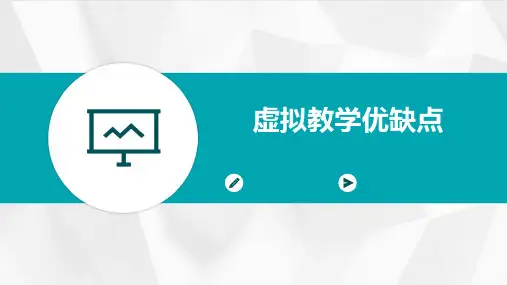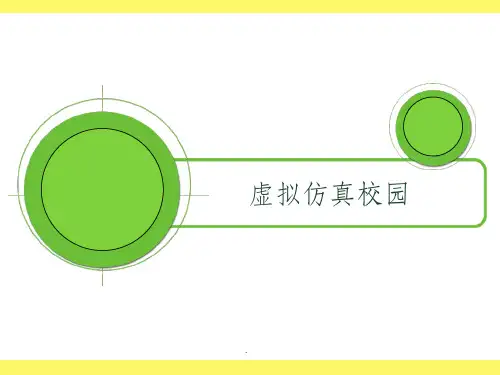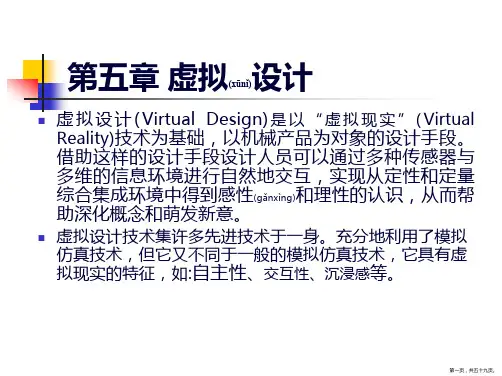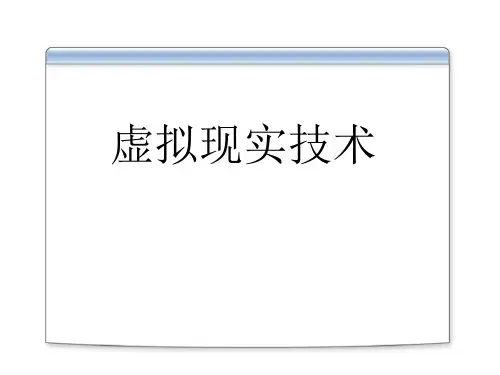虚拟教学优缺点ppt课件
- 格式:ppt
- 大小:575.00 KB
- 文档页数:18











虚拟课堂和真实课堂的优缺点英语作文Virtual Classroom vs. Traditional Classroom: A Comparison of Advantages and DisadvantagesIn today's digital age, technology has transformed the way we receive education. Virtual classrooms have become increasingly popular, offering a new and innovative way of learning. However, traditional classrooms remain the standard form of education for many students. In this essay, we will compare the advantages and disadvantages of virtual classrooms and traditional classrooms.Virtual Classroom:Advantages:1. Convenience: One of the biggest advantages of a virtual classroom is the convenience it offers. Students can access classes from anywhere, at any time, as long as they have an internet connection. This flexibility allows students to balance their studies with other commitments.2. Cost-effective: Virtual classrooms eliminate the need for commuting or purchasing physical textbooks, saving students money. Online courses are often cheaper than traditionalcourses, making education more accessible to a wider range of students.3. Accessibility: Virtual classrooms break down geographical barriers, allowing students from different parts of the world to study together. This diversity can enrich students' learning experiences by exposing them to a variety of perspectives.Disadvantages:1. Lack of face-to-face interaction: One of the main drawbacks of virtual classrooms is the lack of face-to-face interaction between students and teachers. This may hinder students' ability to build relationships with their peers and seek immediate help from their instructors.2. Limited hands-on experience: Some subjects, such as science or art, require hands-on experience that cannot be fully replicated in a virtual setting. Students may miss out on practical learning opportunities that are essential for their understanding of the subject.3. Technical issues: Virtual classrooms rely on technology, which can be prone to glitches or interruptions. Technical issues can disrupt the flow of the lesson and hinder students' learning experiences.Traditional Classroom:Advantages:1. Personalized attention: In a traditional classroom, students have direct access to their teachers, who can provide personalized feedback and support. This individualized attention can help students stay motivated and engaged in their studies.2. Social interaction: Traditional classrooms allow students to interact with their peers, participate in group activities, and develop social skills. These interactions can enhance students' learning experiences and help them build lasting relationships.3. Hands-on learning: Traditional classrooms provide students with hands-on learning experiences that allow them to apply their knowledge in real-world settings. This practical experience can deepen students' understanding of the subject matter.Disadvantages:1. Fixed schedule: Traditional classrooms follow a fixed schedule, which may not be suitable for all students. This rigidity can be challenging for students with busy schedules or those who prefer to learn at their own pace.2. Limited flexibility: Traditional classrooms may not offer as much flexibility as virtual classrooms, making it difficult for students to balance academic responsibilities with other commitments.3. Accessibility: Traditional classrooms may be inaccessible to students who live in remote areas or have physical disabilities. This lack of accessibility can prevent some students from receiving a quality education.In conclusion, both virtual classrooms and traditional classrooms offer unique advantages and disadvantages. The ideal learning environment depends on individual preferences, learning styles, and circumstances. By understanding the differences between these two types of classrooms, students can make informed decisions about their education.。